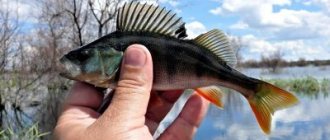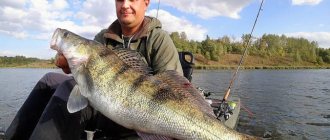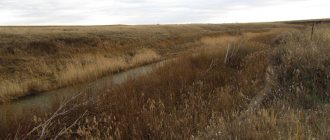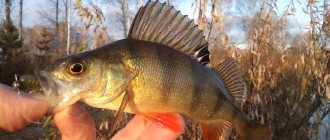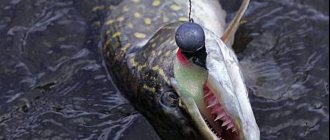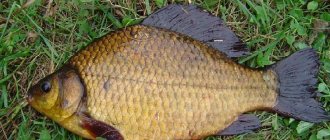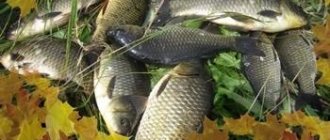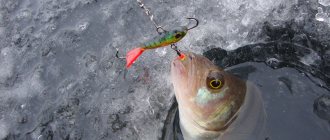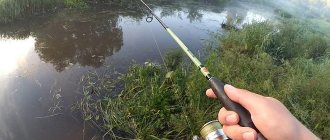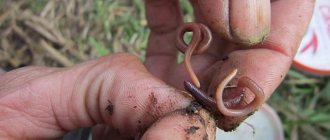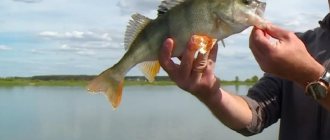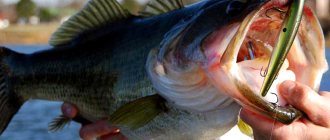Home > Winter fishing > Subtleties of catching perch in November
In November, you can successfully catch any predator, such as pike, pike perch or perch. Of course, the success of fishing will depend on the right approach to choosing equipment, as well as the fishing location. We’ll talk about how to increase your chances and return home with a rich catch in this article.
Perch in November
Despite the fact that many anglers believe that autumn is not the time to pick up a fishing rod due to changeable weather, this is far from true. Perch fishing in November can be quite active, especially in the first half of this month.
During this period, the first ice has already formed on many reservoirs, and a storm often rages on open water.
The perch bite in November cannot be called easy and constant, since the fish during this season are extremely capricious due to the process of adaptation to the upcoming winter cold. Due to the fact that the illumination of the water changes sharply and the temperature drops, the mood of the fish also changes. All these circumstances negatively affect the perch bite in November.
This predator is a diurnal fish, so it can be caught during daylight hours, although early morning and light evening are no less promising. Moreover, it is at this time that the fish are most active.
Features of fish behavior in autumn
It's no secret that with the arrival of autumn, many aquatic inhabitants, including perch, begin to eat intensely. The fish feeds intensely in order to gain fat before the upcoming long winter, so as soon as it starts to get colder, it goes to the shallows, hiding in the coastal vegetation, where schools of fry roam. Fishing for perch in the fall can be very productive, provided that the fisherman responsibly understands all its aspects and subtleties.
The beginning of calendar autumn causes striped predators to form small flocks, which include both small individuals and real trophies. At this time, there are much more large specimens than in spring, because the fish gains impressive weight over the summer period and is now looking for additional food. A decrease in temperature indicators forces the perch to react to any objects of nutritional value, because there is less and less time left before a long and cold winter.
With the arrival of persistently hot weather, the predator looks for shaded places or hides in deep holes. Under such conditions, it should be caught in the morning or evening, because at this time the bite is especially intense. As for fishing in the first days of autumn, the fish demonstrate excellent activity throughout the daylight hours. She chooses fry and all kinds of insects as food. As for artificial baits, here you need to choose small spinner spoons or wobblers.
Do not forget that the success of fishing directly depends on weather conditions. For example, high pressure or strong east winds negatively affect the activity of perch.
To start fishing correctly, it is important to understand the behavior of fish during different periods of the autumn season.
Fishing in September
Catching perch in September is a good chance to get your trophy, because it is at the beginning of autumn that this inhabitant of the depths demonstrates phenomenal activity. A decrease in water temperature causes oxygen levels to rise, which causes fish to rush to any food.
To determine a promising fishing spot, it is enough to carefully observe the reservoir. Where there is a perch, splashes periodically appear, which indicates an active search for the fry by a predator. In most cases, in September, fish can be found on warm shallows and in thickets of coastal vegetation, where there are always small fish. If the fishing is carried out in a large body of water, then the location of the minke whale is easy to determine by the presence of seagulls.
When casting bait from the shoreline, try to move it a little to the left or right of these places. Casting straight can spook the fish and cause it to go deeper . You also need to understand that these schools can change their location, so the fisherman needs to move after them.
Having identified a promising area of the reservoir, begin making the first casts of bait into the water. If there is a bite, followed by a second and third, then the place is good. All that remains is to catch it and sooner or later the trophy will end up on your spinning rod.
Hunting in October
Catching perch in October with a spinning rod is an equally interesting activity. And although the activity of the striped predator is significantly deteriorating, because this is due to changing weather conditions and the gradual movement of the flock to deep places, with the right approach you can arrange very productive fishing for yourself.
It is important to understand that perch stops biting on light baits, especially if the weather is rainy, cloudy and windy. For successful fishing you should use:
- Oscillating spinners.
- Rotators.
- Perch wobblers.
When choosing the optimal wiring option, use a slow pace with certain pauses. After casting, you need to wait until the bait is on the bottom, after which you should lower the tip of the spinning rod and start reeling in the line. If at the beginning of autumn small specimens are caught on the hook, then in October it is quite possible to catch a real trophy, the size of which will be impressive.
November fishing
Catching perch in November requires a more subtle approach and attention. The latest month of autumn significantly changes the previous habits of the fish, so it shows activity only during the daytime. Nevertheless, the bite is as intense as in September, although the fish slide into deep holes and only periodically appear on the surface. Catching perch with a spinning rod in November is a very unpredictable action, because if today a striped predator bites perfectly on any spinning bait, then tomorrow it will be completely passive.
When choosing a suitable bait, it is preferable to use heavy products. A successful fishing result is possible by performing a slow retrieve along the bottom of the reservoir with short pauses when reeling in the fishing line. If fishing is carried out on a river, then fish should be looked for in deep holes . If we are talking about fishing in a still body of water, then in such places it is better to cast from steep banks.
If there is no bite for a long time, try changing baits and fishing techniques..
Where to look for perch in November
The most promising are deep edges, areas near bridges and snags.
Sometimes fishing for perch in November is successful in those places where floaters constantly fished in the summer. The reason is that juveniles of various fish species gradually get used to the feeding areas, thereby attracting the striped predator. Perch fishing in November can also take place in shallow areas of the reservoir, which at the end of autumn become very attractive for fry, because in these places the water is warmer than in the rest of the reservoir. However, it must be taken into account that with the arrival of November and an increase in atmospheric pressure, the perch gradually moves to depth.
Fishing technique
If you are suitably armed, all that remains is to choose the right place, taking into account the time. The leeward shore will provide convenience for the fisherman.
Then the bite will be felt more clearly and even throwing the bait will be much easier, since it flies further. After all, casting range is a serious factor for a good bite.
When you realize that perch is being caught far from the shore, then listen to the advice: a long fishing line does not transmit the bite well. In 50% of cases, the fish hangs, and the person simply feels resistance and may confuse the sensation with a caught shell.
Sometimes there is a slightly noticeable jolt that breaks the silence. Even less often, the fish makes a slight jerk while reeling in. Despite the incomprehensible external manifestations, the perch greedily grabs the bait, leaving only the sinker outside.
Therefore, hooking is not needed, unless there is a distinct bite. When the fish hangs, consider it on the hook, and hooking risks tearing the thin lips.
We recommend that you read:
Fishing can be done using various methods. This is influenced by the type of bait used:
- The spinner assumes uniform wiring with a smooth movement. The bait should be no higher than 25 cm from the bottom. The spoon is considered universal for fishing, as it copes well in different layers of water, both at the very bottom and above the algae. With the help of an oscillating spinner you can diversify your technique. In addition to uniform wiring, you can reproduce the classic jig step in those places where there are differences in depth and ledges. Over bottom obstacles, try wave or step retrieving with the reel speed up to 5, without the bait settling to the bottom.
- The technology for wobblers is varied. Based on uniform wiring, where add pauses. With practice, you can get stop-and-go or individual twitching movements.
- Jigs are not very common here and are more popular abroad. For example, the “Hopkins” series “NO=EQL” seemed to be specially created for November.
- Using a drop shot, light play of the bait in one place is effective. In this case, the sinker remains motionless, and the wiring goes at minimum speed at intervals. You can try using vertical wiring. Then, after waiting for the sinker to fall to the bottom, adjust the slack of the fishing line. Place the end of the rod downwards, ensuring the falling movement of the bait. After a short pause, lift it up with short stretches. Using silicone vibrating tails and twisters, use stepped wiring. Small wobblers should have medium buoyancy or be sinking. A larger bait size will increase idle bites.
It is worth remembering that as the temperature drops, the preferences of the perch change. When the weather drops to zero, he turns more and more attention to baits moving vertically.
Tackle
With the arrival of the first frosts, the water gradually begins to lighten, and the vegetation sinks to the bottom. Experienced fishermen say that the best time to catch perch is in November using a spinning rod. The most catchy rod is a rod weighing from 2 to 21 grams. This will be quite enough for perch fishing in November to bear fruit. There is no need to use leashes: they will unnecessarily alarm the fish and interfere with the graceful play of the bait. There’s no need to be tricky with the fishing line either. With monofilament with a diameter of up to 0.18 millimeters, any perch in November is excellent.
Natural baits
You can also catch perch using natural bait in the fall. However, the classic worm or maggot is ineffective during this period, so experienced fishermen prefer appetizing live bait. Why does live bait demonstrate excellent performance? Everything is very simple:
- Firstly, in response to artificial baits, live bait always moves along a natural trajectory.
- Secondly, when hooking the fry, it was wounded, causing a drop of blood to form. Its smell and appearance strongly attracts any predatory fish.
- Thirdly, the perch will be able to see the fry even in a flowery pond.
However, in addition to significant advantages, live bait baits also have disadvantages . Among them:
- Rapid death of the fry, forcing frequent replacement.
- The likelihood of fish getting caught in coastal vegetation.
- High cost (provided that you buy live bait in a fishing store).
which bait is best to choose , but if you pay attention to a number of useful tips, this will significantly simplify the upcoming choice and allow you to ensure an effective catch. In addition to live bait, you should also take several types of wobblers or spinners for fishing. This will significantly increase the chances of successful fishing, because you can always experiment and choose your ideal option.
For spinning
The closer the onset of winter, the more numerous the flocks of this predator are in the reservoirs. The fish are getting ready to leave for their wintering grounds, so it is believed that the best time to catch perch is in November using a spinning rod.
It should be looked for in the depths. On a large river, anglers consider casting 5 or 10 meters quite normal. In lakes and ponds, you can try to load gear from the steepest shore.
November wiring should be carried out only along the bottom. Since the behavior of this fish is not constant on the eve of wintering, it makes sense to experiment with it. Experienced fishermen use both fast and slow - stepped - wiring options.
How to catch with live bait
Some anglers prefer to fish for whitebait in the fall. However, such a choice only works in warm regions of the country. When stocking up on fry, they are caught with a float rod. They also use donka with live bait. On rare occasions there are mugs.
Often a pond is populated by a large number of humpback whales, then their fry can be turned into bait. After all, the predator bites well on the bait it knows.
This bait is used for float gear and for bottom gear. A float must have a good carrying capacity, otherwise the live bait will simply drown it. Taking into account the strength of the current and the depth, sinkers of 4 grams or more are used. Adjust the depth of the weight so that it is close to the bottom, next to the fry.
Technique
Perch fishing in November involves several types of fishing. The most popular is the smooth one, carried out in the middle thickness of the water. It is most suitable for catching perch with a spoon. Another method is stepped wiring, which is used at great depths. It is suitable for fishing with a wobbler and twister.
Retrieving with stops - a modification of the first two - is used together with a jig. Its essence lies in pausing the bait for a few seconds.
When giving preference to wobblers, it is better to choose those models that are small in size. This significantly reduces the number of empty bites. You can use not only sinking, but also floating types of wobblers. When choosing the second option, the fisherman needs to know that the depth should be kept small. A popper is suitable if it becomes clear that this predatory fish has been attracted by a fry that stays in shallow water. However, this happens quite rarely, so catching perch in November with a popper is a rarity among anglers.
Fishing with a jig
When thinking about what perch bites on, you should use another method - microjig. It brings excellent results and provokes even sluggish, passive fish to attack.
The microjig differs from the usual one in the weight and size of the head. Its weight should correspond to the depth in the area intended for fishing. The most popular, weighing up to 7 g.
Having settled on light equipment, you need to take into account the performance of the spinning rod. Choose with dough not exceeding 10 grams and with a minimum of zero. Thanks to this, even light touches of the predator can be noticed and the strike can be carried out in time.
The only thing that is effective is jig options in familiar water areas, where you won’t find submerged stumps and snags.
Small, up to 5 cm, silicone worms, as well as vibrotails and twisters are used as bait. Edible silicone works best. When working at a decent depth, you can not pay attention to color.
If the water is clean and clear, give preference to natural colors: white, silver, yellow, light green and smoky. Lures in acidic and bright colors are suitable for muddy water.
Jig equipment
The jig head is selected for the conditions, taking into account the size of the bait. This option is classic. Articulated rigs work great for perch. She represents an offset hook with a Cheburashka sinker; a jig-rig is also suitable.
Jig-rig is similar to the classic version, but significantly changes the tactics. It is possible to cover a large field and animate floating silicone even at a minimum wiring speed.
Being almost in place, crayfish and similar animals reproduce perfectly. All you need is a slight twitch of the spinning rod.
In conditions of fast current or deep water, heavy heads and sinkers will be needed, but this hinders normal play. Thus, slow wiring will not be possible. In this case, you can use exploded snap-ins:
- A diverting leash is well suited for currents. A heavy sinker lies on the bottom, and a leash with bait and a hook at a distance from the load stands in the water column.
- The drop shot is good for vertical fishing. When hunting from piers, bridges, steep banks and from a boat. This method breaks off local deep places. The hook is located on the main line, above the sinker, about 50 cm or at a distance slightly less.
Spoon
In the last autumn month, the spoon is the most versatile bait, since it can be used in various water layers: both above the grass and near the very bottom. The spinner should have high drag when the blade is deflected by sixty degrees. You need to be able to hold it quite easily in a given water horizon, including during slow retrieval.
Spinners up to No. 3 are more suitable for fishing the shallowest areas of a reservoir, for example, with a depth of up to one and a half meters or overgrown with aquatic vegetation. Anglers use larger numbers more often in places where the tackle can be lowered two to three times deeper. In general, a spinner is considered universal, but it is not the first on the list of baits used to catch perch in November.
When and where to catch perch in the fall
To begin with, it is necessary to highlight such a factor as current. It is fundamental and determines the nature and habitat of the perch. As you know, all reservoirs are divided into two types:
1. Rivers (natural flow), reservoirs (flow regulated by hydraulic structures).
2. Reservoirs that do not have a current (lakes and ponds).
In relation to rivers and reservoirs, several characteristic habitats can be distinguished:
1. Coastline of aquatic vegetation adjacent to clear water.
2. Extensive shallow waters without sudden changes in depth.
3. Old flooded streams adjacent to the riverbed.
4. Places of confluence of small rivers, exits from oxbow lakes.
5. Any flooded individual snags, stumps located at a depth of up to 5 meters.
6. River sections after rapids.
If we are considering lakes and ponds, then we need to consider the following places:
1. Coastline with grassy vegetation.
2. Any changes in relief at a depth of up to five meters.
3. Lake bays.
4. Man-made structures (dams, bridges).
5. Places where streams flow.
As for the fishing time, it’s definitely during daylight hours; at night the perch is not active. The most favorable times for successful spinning fishing are dawn, midday, and just before sunset.
For microjig
It is he who enjoys the greatest popularity among lovers of “silent hunting”. Every fisherman necessarily faces the question of choosing not only promising places, but also equipment. By choosing the right bait and area, the angler is guaranteed to be successful in catching perch in November. However, this is not so easy to do.
A microjig differs from a regular jig only in the size of the bait and the weight of the head; in all other respects they are the same. For fishing, you can use the same twisters or vibrotails. The weight of the head should be selected depending on the depth of the intended fishing spot. Perch fishing in November with this equipment works best at a distance of one and a half to four meters from the surface, so the weight of the heads should be in the range from 2 to 7 grams.
What does it bite on?
In the last month of autumn, various baits are used: medium-sized wobblers and spinners. Often a twister with a length not exceeding 5 cm is used. It is very convenient to fish with a lead or rubber with a small load.
Practice shows that vibrating tails and twisters bring the best results. The main thing is that after casting the bait does not come off the bottom by more than 5 cm. It’s even better when it slowly creeps into one.
This movement causes a reaction from the predator. Proper selection of bait, successful casting and retrieving is of great importance.
Oscillating spoon
Compared to a turntable, an oscillator produces low-frequency play. Therefore, it attracts medium-sized large-scale perch a little less well.
But for large fish at great depths it is the best option. Also, an oscillating spoon will allow you to make long casts. They are often caught with elongated spoons from 3 to 7 cm. A type that has received a special name - micro-oscillators - is also suitable.
Spinners with rotation
A truly universal bait is good in the water column at shallow depths, in shallow bodies of water such as ponds, lakes, and medium-sized rivers.
Perch responds well to high-frequency game, which can be easily ensured with uniform wiring. Mastering this method is quite simple. A serious disadvantage of the spinner is the lack of long-distance bait casting and the inability to fish at depth.
The exception is front-loaded turntables. When choosing a spinner for November, choose heavier models than for fishing throughout the year. After all, it will be necessary to fish at a decent distance and depth.
Wobblers
Let us immediately note that the effectiveness of the wobbler is inferior to other options. There are conditions when small baits from 2 to 5 cm give good results.
At the end of autumn, the perch is more at depth, so the use of small wobblers becomes impossible. However, in conditions up to 5 m, small samples - cranks, minnows and high-frequency fetas - are perfect.
